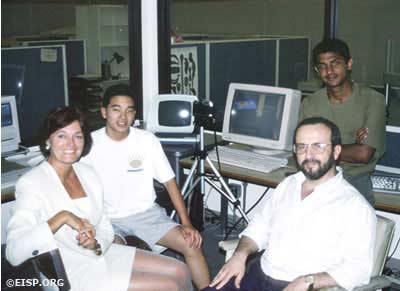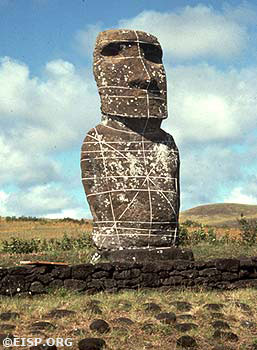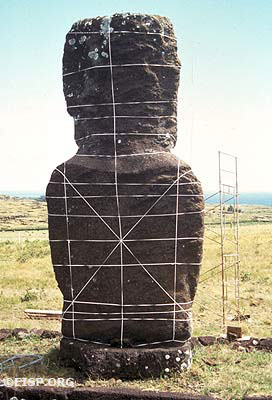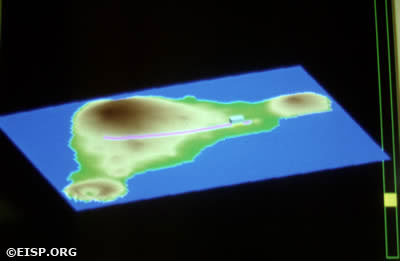Easter Island Statue Project History: 1990s
Goals and Methods
Major goals from 1990 to 2000 were to further expand our field work beyond the published survey area and to include Ahu Tepeu and a wide variety of interior sites; to add to our database those statues found in museum collections, and to gather comparative data from other Polynesian monolithic statue sites in Mo’orea, the Marquesas Islands and Tonga. New object type categories were created to accommodate expanded iconographic fields, including the more intensive recording of rock art directly related to statues or statue sites. Van Tilburg and Cristián Arévalo Pakarati worked independently or together throughout much of this time. Field seasons were short, usually 3 to 4 weeks every year, although two field seasons were accomplished back-to-back in each of two years.
In the Field
We worked intensively at Ahu Tepeu, where our goal was to integrate the excavation data from previous work with the on-site statue data and with descriptions of sculptural objects in museum collections. At Vai Mata, we documented the associated hare paengaand other features more fully and, as well, accomplished a preliminary survey of Quadrant 26. We mapped several interior sites and moai fragments at La Pérouse, using new hand-held GPS and video equipment as important tools.
Arévalo Pakarati concentrated his attention upon the moai in Chilean museums on the island and the mainland, including Viña del Mar, Santiago and La Serena. He followed up the work begun two years earlier when Van Tilburg documented 4 of the 5 statues on the mainland and, in addition, researched archive documents relating to them and to one other statue. He gleaned further ethnographic data from Felipe Teao, Papa Kiko, Alberto Hotus and his grandmother, Amelia “TeTe” Tepano Ika. All of this information was eventually integrated into the EISP database and some of it was published in 1992.
A subset of 134 statues possessing 10 crucial measurements of overall form was analyzed to produce the statistically average statue (4.05 m tall). Statue 01/53 at Ahu Akivi (16-001), an inland ceremonial site lying about 140 m above sea level on the southwestern slope of Maunga Terevaka, was pinpointed as a “reference” statue. Ahu Akivi is reliably dated to after AD 1400 and before the mid-1600s.
Photogrammetric data were collected on Statue 01 with the help of National Geographic Photorgrapher Jim Amos and architect Johannes Van Tilburg. These data were amplified through the creation of an accurate 1/10-scale model. It was then used to formulate a wide variety of hypothetical transport configurations and laser scanned. The resultant three-dimensional computer image was cross-checked in the field. The wire diagram was then employed in digital tests designed to evaluate and refine three hypothetical transport configurations. UCLA’s Laboratory for Robotics and Animation, directed by Dr. Zvi Shiller, generated three alternative paths from Rano Raraku, where the statue would have been carved prehistorically, to Ahu Akivi, the “target site” 10-15 km away (depending upon the path).
Findings
The projected number of people involved in the transport task varied slightly on all three routes, and depended on terrain difficulty. We concluded that the average pull crew required for Path 1 was 48 people, and the maximum force required to pull the statue was 2.5 tons. Computer modeling suggested that 55-70 people (or 48 average) were required to pull the average statue of 12 m tons over Path 1, and that their collective food requirement would have totaled 201,600 calories per day from agricultural staples such as sweet potatoes and bananas. In 1998, our successful, full-scale experiment using a replica statue demonstrated that 40 people were fully capable of pulling a 10 m ton statue.

Jo Anne Van Tilburg, Zvi Shiller (left) and Satish Sundar (left, rear) at UCLA for computer modeling of the transport experiment. ©1993 EISP/JVT.
 English
English  Español
Español 

